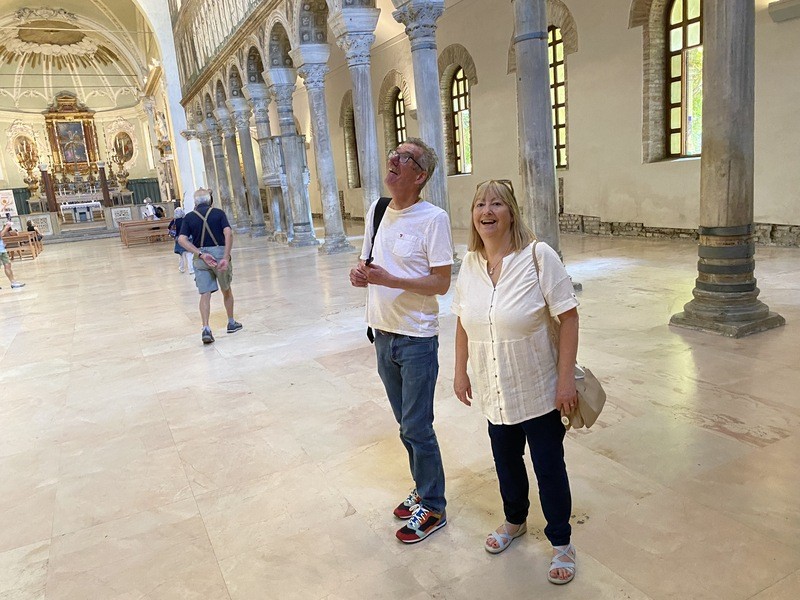The last week of September we kicked off another course in Bologna, my hometown, the beautiful capital of Emilia-Romagna. I had an amazing time together with my students Dave and Diane who have been my students for a very long time. I started to teach them more than 10 years ago when I used to live in England. In this picture they look very happy standing in front of the beautiful “Finestrella di Via Piella”.

Today, it’s a well-known secret that best spot to see one of the few remaining sections of the historic canals is through the small “Canal Window” on Via Piella. From the unassuming street, you can peek out over a portion of Canale delle Moline, which was an uncovered part of the network, later flanked by houses and buildings obscuring it from view. The water flows between brightly colored houses on one side and the walls of an unpainted brick building on the other. It’s a quaint and picturesque sight, which is why for a “secret” window, Finestrella di Via Piella gets an awful lot of visitors.
Very few people know that Bologna in the ancient time looked a bit similar to Venice. In the 12th century, canals were built on the city’s major rivers, the Savena and Reno, complete with a sophisticated hydraulic system of locks and pipes. The network was extensive, spanning more than 37 miles. The waterways through the city were used for silk manufacturing and trade, and Bologna became a major hub for silk, along with the city’s flourishing tobacco and flour trade.
At the beginning of the 20th century, as these trades lost importance for the economy of the city, the local authorities decided to cover them transforming completely the aspect of the city. Many people from Bologna don’t even know that this system of canals used to exist
I kept a photographic diary of this amazing week of italian lessons and I would like to share it with you!
Monday, Wednesday and Friday morning
Lessons were held in the beautiful apartment rented by Dave and Diane. The apartment is strategically placed, just 10 minutes walk to the station and 15 minutes walk to the center of Bologna.

After the lunch break, during our afternoons, the lesson continued in the center but it became a walking one. We saw together the main attractions and the hidden gems of Bologna.
San Petronio Basilica where we saw as well the amazing Foucault pendulum.
The anatomical theatre and the “stabat mater” hall, both inside the Archiginnasio once the palace of University of Bologna, now a beautiful library.
Santo Stefano's Basilica: the most unique complex in Bologna, as it is a true city sanctuary and the cradle of our ancestor’s faith. It is mainly known as “sette chiese” (“seven churches”) because it is the merger of multiple buildings erected in different eras.
The origins of the complex are controversial and disputed. According to the most accepted theory, it was built by Petronius, a bishop who is now the saint protector of the city, on the ruins of a pre-existing pagan temple, flanked by a reproduction of the Holy Sepulchre in Jerusalem which you see in the picture below
The church of Santa Maria della Vita (Saint Mary of the life) located in the Quadrilatero, the beating heart of the historical centre of Bologna; it houses the famous “Lamentation over the Dead Christ" (Compianto sul Cristo Morto) by Niccolò dell’Arca, dating back to the second half of the 15th century and called the "Scream of stone" by Gabriele D 'Annunzio.
The complex also houses another sculptural group called “the transit of the virgin”, representing a very dramatic scene taken from an Apocryphal gospel
TUESDAY
We went by train to Ravenna to see its beautiful buildings and its mosaics which are exquisite and decorate the inside of every single monuments. My students looked indeed very surprised when they saw their brightness.

What looks like just a collection of tiny, bright tiles is in reality a vivid image of a sea voyage, an image of Jesus, or a choir of angels: I sometimes wonder how long each of these mosaics must have taken to create. What talent they had!
After visiting the main sites in town, on the way back to the station Dave and Diane paid a tribute to Dante Alighieri, the “initiator” of modern Italian, whose tomb is in Ravenna

Thursday
We went to Ferrara by train, a beautiful small city, just 30 minutes away from Bologna. Once just an unimportant town, it became one of the most important European cultural centers during the renaissance.
The Este family, lords of the cities for nearly 300 years made Ferrara beautiful building a castle, some fantastic palaces and an extension to the city. Here you find some pics taken in and around the castle, a beautiful fresco relating to the month of April and May in the beautiful months’ hall in the Schifanoia Palace and a lunch break at a restaurant near the castle where we had “pasticcio di maccheroni”, a baked pasta typically from Ferrara.
It was indeed a great week! Italian Tutor experience’s aim it’s not just learn Italian in Italy but indeed to get the students to discover other aspects of Italy, such as food, wine and art and above all get them to mingle with Italian people so that they can get constant feedback about their improvement from the locals: the best way to learn the language!































